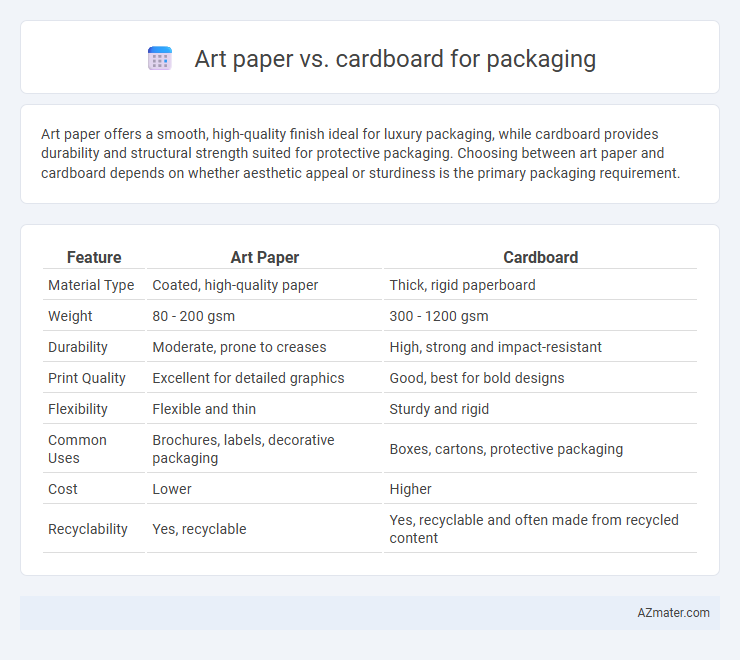Art paper offers a smooth, high-quality finish ideal for luxury packaging, while cardboard provides durability and structural strength suited for protective packaging. Choosing between art paper and cardboard depends on whether aesthetic appeal or sturdiness is the primary packaging requirement.
Table of Comparison
| Feature | Art Paper | Cardboard |
|---|---|---|
| Material Type | Coated, high-quality paper | Thick, rigid paperboard |
| Weight | 80 - 200 gsm | 300 - 1200 gsm |
| Durability | Moderate, prone to creases | High, strong and impact-resistant |
| Print Quality | Excellent for detailed graphics | Good, best for bold designs |
| Flexibility | Flexible and thin | Sturdy and rigid |
| Common Uses | Brochures, labels, decorative packaging | Boxes, cartons, protective packaging |
| Cost | Lower | Higher |
| Recyclability | Yes, recyclable | Yes, recyclable and often made from recycled content |
Introduction to Packaging Materials
Art paper offers a smooth, high-quality surface ideal for premium packaging that enhances brand presentation through vibrant print clarity and fine detail reproduction. Cardboard, known for its durability and structural strength, provides excellent protection and rigidity, making it suitable for shipping and heavier products. Choosing between art paper and cardboard depends on balancing aesthetic appeal and protective functionality in packaging design.
Understanding Art Paper: Features and Uses
Art paper is a high-quality coated paper known for its smooth surface and excellent printability, making it ideal for vibrant packaging designs. It offers good stiffness and durability but is generally thinner and less rigid compared to cardboard, which limits its use in protective packaging. Commonly used for luxury product boxes and cosmetic packaging, art paper enhances visual appeal while providing sufficient strength for lightweight items.
Cardboard Explained: Types and Applications
Cardboard, a versatile packaging material, comes in various types such as corrugated, chipboard, and solid board, each designed for specific applications ranging from lightweight product protection to heavy-duty shipping containers. Corrugated cardboard features fluted layers that provide superior strength and cushioning, making it ideal for transporting fragile items, while chipboard is commonly used for retail packaging and rigid boxes due to its smooth surface and printability. Solid board, thicker and denser, offers robust protection for luxury and high-end packaging, emphasizing durability and aesthetic appeal in product presentation.
Comparison of Durability: Art Paper vs Cardboard
Art paper offers a smooth surface ideal for high-quality printing but generally lacks the durability and structural strength of cardboard, making it less suitable for heavy or bulky packaging. Cardboard provides superior impact resistance and rigidity, ensuring better protection for packaged goods during shipping and handling. For packaging applications requiring both aesthetic appeal and durability, combining art paper as an outer layer with cardboard as the core is a common practice.
Print Quality: Art Paper vs Cardboard Packaging
Art paper offers superior print quality with smooth, glossy surfaces that enhance color vibrancy and detail clarity, making it ideal for high-resolution images and intricate designs in packaging. Cardboard, while more robust and protective, typically features a rougher texture that can absorb ink unevenly, resulting in less crisp prints and muted colors compared to art paper. For packaging requiring premium visual appeal and precise branding, art paper outperforms cardboard in delivering sharp, vivid prints.
Cost Analysis: Choosing Between Art Paper and Cardboard
Art paper offers a premium finish with higher print quality but incurs greater material and production costs compared to cardboard. Cardboard provides a cost-effective packaging solution, balancing durability and affordability, especially for bulk orders and heavier products. Selecting between art paper and cardboard depends on budget constraints and the desired presentation impact for the packaging project.
Sustainability and Eco-Friendliness
Art paper and cardboard differ significantly in sustainability and eco-friendliness; cardboard is generally more sustainable due to its higher recyclability and biodegradability, often made from recycled fibers and requiring less energy to produce. Art paper, especially coated or glossy types, may contain plastic-based finishes that hinder recycling and increase environmental impact. Packaging solutions prioritizing eco-friendliness favor cardboard for its lower carbon footprint and easier integration into circular waste management systems.
Design Flexibility and Customization
Art paper offers superior design flexibility and customization options compared to cardboard, enabling high-resolution printing and vibrant color reproduction ideal for premium packaging. Its smooth surface supports intricate patterns, embossing, and foil stamping, enhancing visual appeal and brand identity. While cardboard provides durability, art paper allows brands to achieve more detailed and visually striking packaging designs tailored to specific marketing needs.
Best Use Cases for Art Paper Packaging
Art paper packaging is ideal for luxury product presentation, such as cosmetics, perfumes, and high-end electronics, due to its smooth finish and excellent print quality. Its versatility supports vibrant colors and fine details, enhancing brand appeal and consumer perception. Art paper's lightweight nature also makes it suitable for lightweight items requiring elegant, visually appealing packaging without compromising sustainability.
Ideal Scenarios for Cardboard Packaging
Cardboard packaging is ideal for heavy-duty shipping and product protection due to its sturdiness and shock-absorbing properties. It excels in scenarios requiring eco-friendly, recyclable materials suitable for bulk packaging and retail displays. Its versatility makes it perfect for e-commerce shipments, food containers, and storage boxes where durability and cost-effectiveness are essential.

Infographic: Art paper vs Cardboard for Packaging
 azmater.com
azmater.com